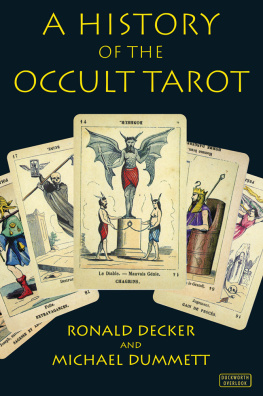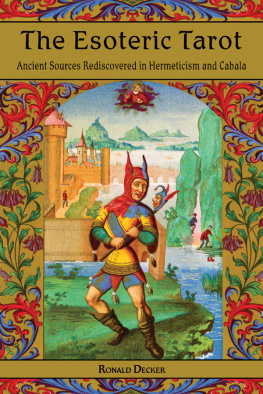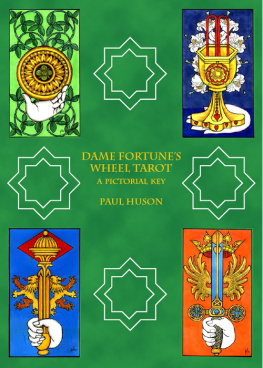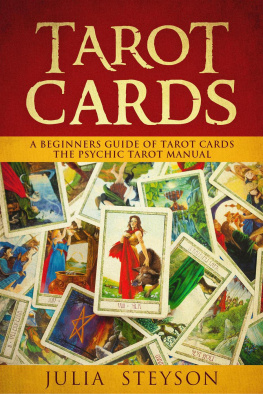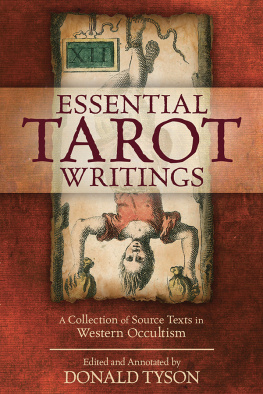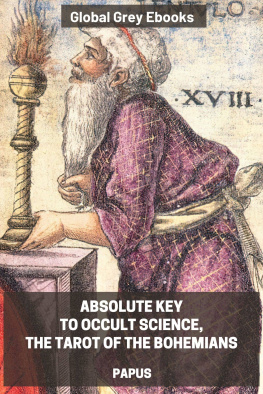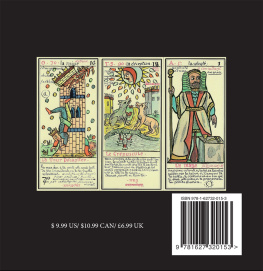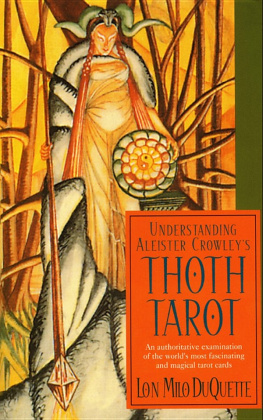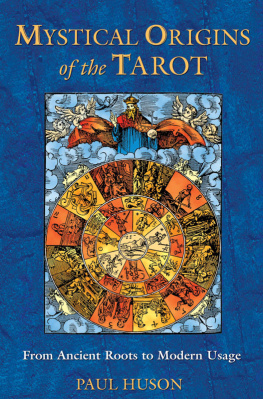A History of the Occult Tarot
A History of the
Occult Tarot
1870-1970
Ronald Decker
and
Michael Dummett

Duckworth Overlook
This eBook edition 2013
This edition first published in the UK and US in 2013
First published in 2002 by
Duckworth Overlook
LONDON
30 Calvin Street, London E1 6NW
T: 020 7490 7300
E:
www.ducknet.co.uk
NEW YORK
141 Wooster Street, New York, NY 10012
www.overlookpress.com
2002 by Ronald Decker and Michael Dummett
All rights reserved. No part of this publication
may be reproduced, stored in a retrieval system, or
transmitted, in any form or by any means, electronic,
mechanical, photocopying, recording or otherwise,
without the prior permission of the publisher.
The right of Ronald Decker and Michael Dummett to be
identified as the Authors of the Work has been
asserted by them in accordance with the
Copyright, Designs and Patents Act 1988.
A catalogue record for this book is available
from the British Library
ISBNs
Paperback: 978-0-7156-4572-7
Kindle: 978-0-7156-4704-2
ePub: 978-0-7156-4705-9
Library PDF: 978-0-7156-4706-6
Contents
To the memory of Donald Laycock
Plates
Foreword
A scholarly book on Tarotism was conceived by Michael Dummett and Donald Laycock, an Australian anthropologist to whose memory this book is dedicated. Sadly, at the very beginning of 1989, his intended co-author learned that Laycock had contracted a form of leukaemia and could no longer work; his death followed very soon after. The project seemed in danger of dying with the Australian author. However, it was revived through collaboration with Ronald Decker and Thierry Depaulis. The material amassed by the three of us became so sizeable that it compelled a division of the one-volume project into two. We published in 1996, under the title A Wicked Pack of Cards, a study of the esoteric uses of Tarots in France from the first evidence up to the early XX century. We described the major packs, both esoteric and divinatory, published in the period under discussion. We provided biographical data on the major theorists; we explained their innovative thoughts, their unacknowledged sources and their programmes of symbolism. We indicated certain misconceptions and misrepresentations.
Some of our readers complained that our book was not the one they really wanted to see written. They would have preferred that we had written as metaphysicians, semioticians, mythographers or iconographers. These perspectives could yield valuable views of the esoteric Tarot, but they cannot receive proper delineation in one book. We had noted that Tarotism lacked a simple, honest, thorough chronicle. That is the book that we intended to provide.
The earliest evidence of the Tarot comes from the courtly circles of northern Italy in the 1440s. The pack probably was invented there in the 1420s. Its only indicated use was for playing a card game. The Tarot in its original form included four suits, of Swords, Batons, Cups and Coins, each suit being composed of ten numeral cards from Ace to 10 and four court cards Jack, Knight, Queen and King. The four suits were the ordinary ones then used in Italy, and still used in many parts of it, for regular playing cards; the Knight was a standard court figure in Italian packs, the Queen being added for the Tarot. The unique feature of the pack is the presence of 21 picture cards properly called trumps, and a single card called the Fool. The trumps form a sequence, very often numbered from I (low) to XXI (high). They represent stock figures such as the Pope, Justice, Death and the Sun. The subjects depicted were originally everywhere the same, but their order and numbering differed markedly in different regions of Italy. It was the addition of the Fool and the trumps that essentially constituted the invention of the Tarot pack. The first Tarot games diversified into a large family of them, still played in parts of Italy, France, Switzerland, Denmark, the Black Forest, Austria, Hungary, the Czech Republic and Slovenia, and formerly in every country of Europe save Britain, the Iberian peninsula and the former Ottoman Empire. These are all trick-taking games; everywhere but in France and Sicily, the original practice was maintained of ranking the numeral cards differently in different suits. In all four suits the four court cards ranked highest; in Swords and Batons (Spades and Clubs) the cards then ranked 10, 9, ..., 2, Ace, but in the other two suits in the reverse order, Ace, 2, ..., 9, 10. In France and Sicily, the numeral cards had a uniform order, from 10 downwards, in all four suits.
A little before 1750, players of Tarot games in Germany radically changed the pack's appearance. They left intact its structure and the rules of the game, but adopted the familiar French suit-signs of Spades, Clubs, Hearts and Diamonds in place of the Italian ones. The traditional figures were dropped from the trump cards; these were henceforth distinguished primarily by the inscribed numerals. The imagery now was of animals, genre scenes or other arbitrary designs. By the end of the XVIII century these French-suited Tarots had, for purposes of play, replaced the Italian-suited ones everywhere save in France, Switzerland and Italy. French players went over to using them around the beginning of the XX century.
Modern cartomancy arose only in the XVIII century: packs of cards were shuffled, dealt and spread in prescribed formats for telling the future. The earliest instance of Tarot cartomancy occurred in Bologna, but the familiar variety, surviving today, descends from French fortune-tellers. First, they assigned divinatory meanings to the cards of the common Piquet pack, which had French suit-signs. Jean-Baptiste Alliette (1738-91), a Parisian diviner better known as Etteilla, transferred his Piquet cartomancy to the Tarot. By this time the game of Tarot had ceased to be played in France outside its eastern region so, to Parisian seers, the Tarot seemed mysterious and exotic. Etteilla and others infused the Tarot with occult sciences. This resulted in the production of new Tarots, to be used for common fortune-telling, yet designed to express some cosmic theme. Here were the beginnings of the trend nowadays called Tarotism.
The French Tarotists of the XVIII and XIX centuries identified as the traditional Tarot the version used in France, known as the Tarot de Marseille and derived from a Milanese prototype. They took the order and numbering of the trumps found in it to be the Tarot order and numbering, being unaware of the other orders, ancient and current; they were equally unaware of the different rankings in the different suits observed almost everywhere but in France. These oversights were inherited by Tarotists in other lands.
Some Tarotists belonged to secret societies, claimants to ancient wisdom; but when they published about the Tarot, they did not necessarily claim to derive their knowledge from arcane instruction. More often, each was proud to advertise his insight as highly intuitive. However, their theories of the Tarot's genesis placed it among secretive types, such as Egyptian priests, magicians, alchemists, Cabalists and Templars. In the most prevalent interpretation of the Tarot trumps, they were forced into alignment with the Hebrew alphabet, so that the Tarot could be interpreted in terms of Christian Cabalism. The Cabala was likewise said to be interpretable only in the light of the Tarot. By this means, a pack of playing cards was integrated into a whole system of Western magical theory. The originator of this idea was liphas Lvi (1810-75), the first modern synthesiser of Western occultism.

